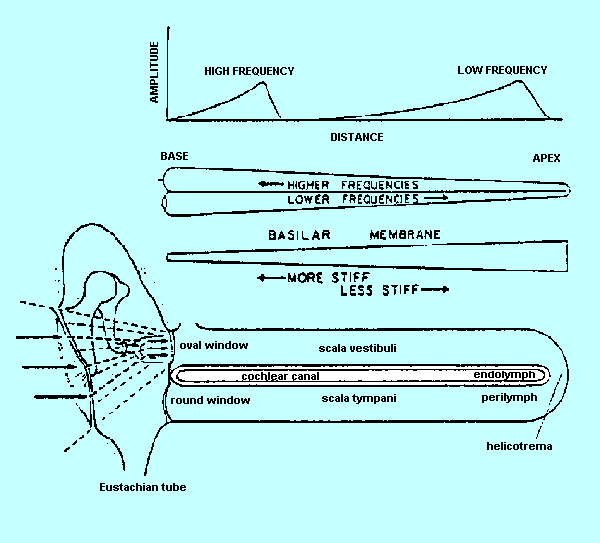
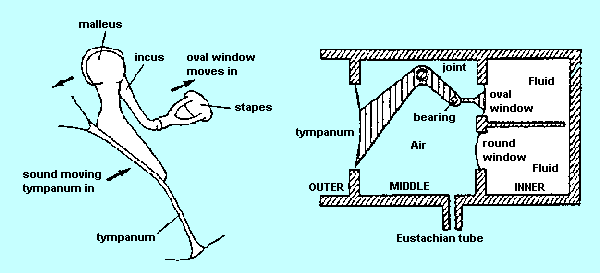
Sound waves enter outer ear, cause vibrations of tympanic membrane (tympanum, eardrum)
Tympanic membrane vibrations are transmitted through middle ear ossicles
to the inner ear (cochlea) via the oval window.
The ossicles provide small amount of amplification, but their main
role is impedance matching.
The tympanic membrane vibrates in air; the oval window vibrates fluid
in the cochlea, hence more `energy' is required to move the more viscous
fluid.
Differences in areas of tympanum and the oval window act to increase
the driving pressure.

The basilar membrane varies in width and stiffness along its length.
It is most sensitive to high frequency vibrations at its apex (furtherest
from the oval window), and most sensitive to low frequency vibrations at
its base (nearest the oval window).
See Fig. 3.5 and section 3.2.5 of Book 3.
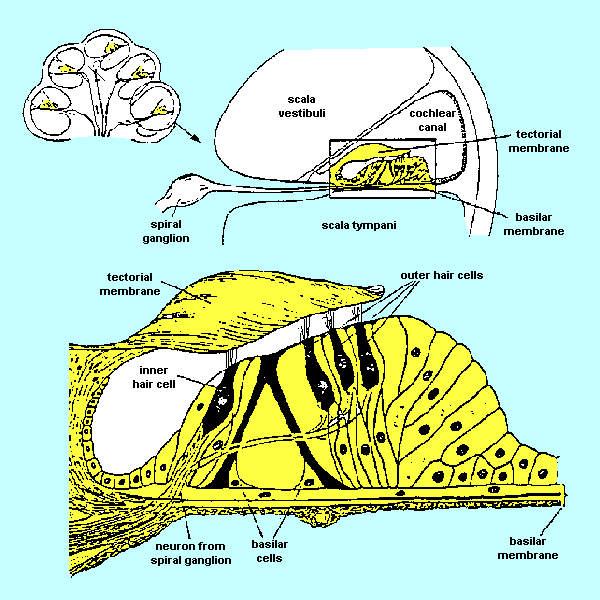
Sound frequency is coded by where on the basilar membrane the amplitude
of vibrations is the greatest.
Basilar membrane vibrations stimulate hair cells (receptors) that are
attached to it.
The ends of the sensory hairs are embedded in the tectorial membrane.
Hair cell receptor potentials generate action potentials which pass
via the cochlear nerves (their cell bodies are in the spiral ganglion -
see Fig) to the brainstem and thence to auditory cortices in temporal lobes.
Each cochlear neuron is tuned to a narrow band of frequencies.
This is probably because it innervates a small population of hair cells
associated with a particular pan of the basilar membrane.
Majority of vocal sounds are `voiced' (vocal fold vibration). Some sounds are `unvoiced' (no vocal fold vibration), e.g. f and ss .
Fundamental frequency of sound determined by vocal folds. Frequency
of vibration: length and tension of folds. Additional harmonics reflect
the resonant frequencies of the resonators of the upper vocal tract; these
add the quality (timbre) of the voice.
Vowels: uninterrupted airflow; form of sound determined by position
of tongue, lips
Consonants: airflow interrupted in different ways:
Plosives (Stop consonants): airflow briefly stopped
and released suddenly, e.g. d, t, g, k, b, p.
Fricatives: airflow past constriction, e.g. f,
v, th.
Affricatives: involve partial blockage of airflow,
e.g. ch, j, l, r.
Nasals: airflow through nose, e.g. m, n, ng.
Sonagram (voice print): plots sound frequency (vertical axis) and frequency (intensity of banding) against time. Allows analysis of phoneme form.
Phonemes: individual units of speech (analogous to letters used
in writing or printing)
>40 different phonemes in English (many vowels can be sounded in different
ways, e.g. car, care)
Analogy with variable form of letters in cursive writing demonstrates
coarticulation: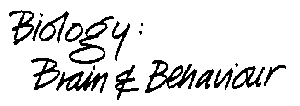
| Types of dysphasia: | Broca's dysphasia | Wernicke's dysphasia |
| Site of lesion: | Inferior end of motor cortex | Posterior, superior temporal gyrus |
| (Area 44) | (Area 22) | |
| Fluency: | Poor; effortful speech | good |
| Comprehension: | intact | impaired |
| Neologisms, etc.: | absent | present |
| Communication: | adequate | poor |
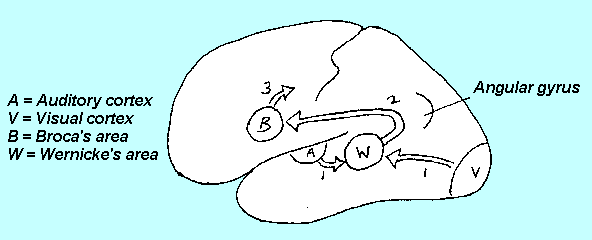
In the majority of people, language function is unilateral and is located in the left cerebral hemisphere
The table below shows linguistic dominance and handedness.
|
|
|
||
|
|
|
|
|
|
|
|
|
|
|
|
|
|
|
|
|
|
|
|